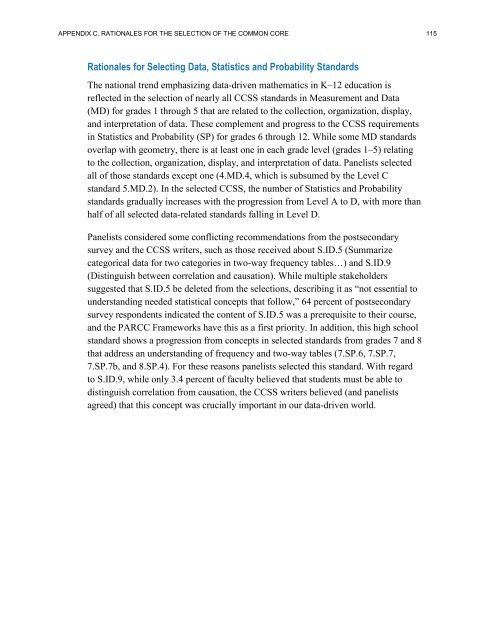CCRStandardsAdultEd
Create successful ePaper yourself
Turn your PDF publications into a flip-book with our unique Google optimized e-Paper software.
APPENDIX C. RATIONALES FOR THE SELECTION OF THE COMMON CORE 115<br />
Rationales for Selecting Data, Statistics and Probability Standards<br />
The national trend emphasizing data-driven mathematics in K–12 education is<br />
reflected in the selection of nearly all CCSS standards in Measurement and Data<br />
(MD) for grades 1 through 5 that are related to the collection, organization, display,<br />
and interpretation of data. These complement and progress to the CCSS requirements<br />
in Statistics and Probability (SP) for grades 6 through 12. While some MD standards<br />
overlap with geometry, there is at least one in each grade level (grades 1–5) relating<br />
to the collection, organization, display, and interpretation of data. Panelists selected<br />
all of those standards except one (4.MD.4, which is subsumed by the Level C<br />
standard 5.MD.2). In the selected CCSS, the number of Statistics and Probability<br />
standards gradually increases with the progression from Level A to D, with more than<br />
half of all selected data-related standards falling in Level D.<br />
Panelists considered some conflicting recommendations from the postsecondary<br />
survey and the CCSS writers, such as those received about S.ID.5 (Summarize<br />
categorical data for two categories in two-way frequency tables…) and S.ID.9<br />
(Distinguish between correlation and causation). While multiple stakeholders<br />
suggested that S.ID.5 be deleted from the selections, describing it as “not essential to<br />
understanding needed statistical concepts that follow,” 64 percent of postsecondary<br />
survey respondents indicated the content of S.ID.5 was a prerequisite to their course,<br />
and the PARCC Frameworks have this as a first priority. In addition, this high school<br />
standard shows a progression from concepts in selected standards from grades 7 and 8<br />
that address an understanding of frequency and two-way tables (7.SP.6, 7.SP.7,<br />
7.SP.7b, and 8.SP.4). For these reasons panelists selected this standard. With regard<br />
to S.ID.9, while only 3.4 percent of faculty believed that students must be able to<br />
distinguish correlation from causation, the CCSS writers believed (and panelists<br />
agreed) that this concept was crucially important in our data-driven world.


